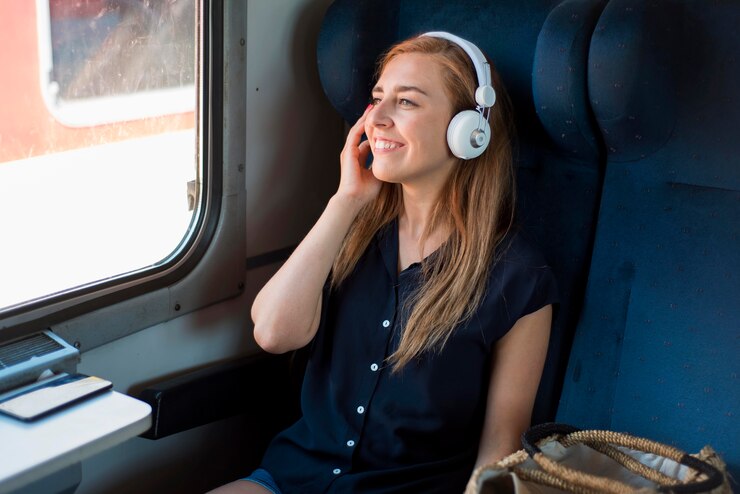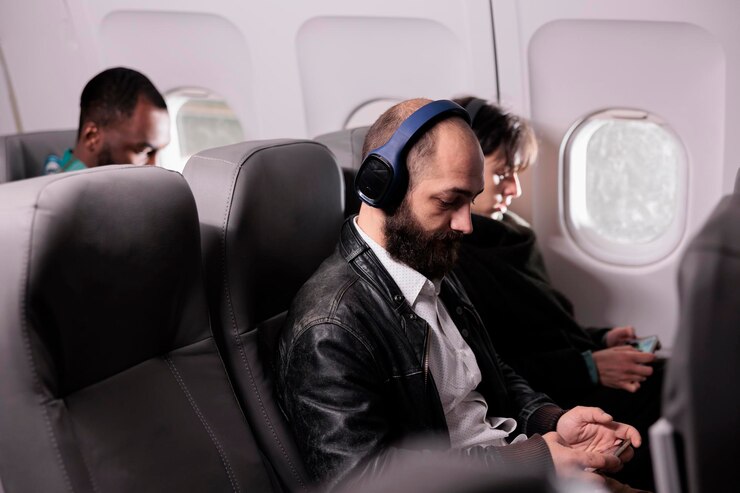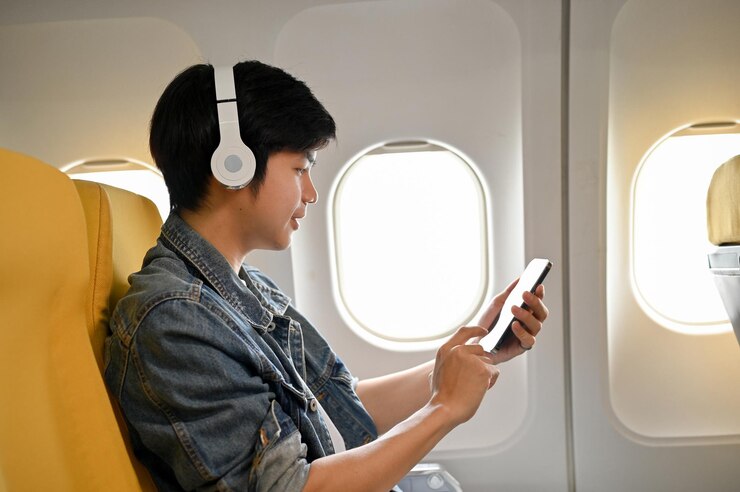Yes, headphones can help with airplane pressure by reducing the discomfort caused by the change in air pressure. Airplane travel can sometimes be accompanied by uncomfortable changes in air pressure, leading to pain and pressure in the ears.
However, using headphones during a flight can alleviate this discomfort by creating a constant and equalized pressure in the ear canal. This is particularly useful during takeoff and landing when the air pressure changes most significantly. By blocking out external noise and providing a distraction, headphones also help reduce anxiety related to flying.
Additionally, listening to soothing music or audio during the flight can further enhance relaxation and comfort. Overall, wearing headphones during a flight can greatly contribute to a more enjoyable and comfortable travel experience.

Benefits Of Using Headphones During Flights
Headphones are beneficial for managing airplane pressure during flights. They help reduce discomfort by providing a distraction from the fluctuating cabin air pressure.
Airplane journeys can be uncomfortable, especially during takeoff and landing when cabin pressure changes. However, using headphones during your flight can bring several benefits. Let’s explore the advantages of using headphones in more detail.
Noise Cancellation Technology
- Enjoy a peaceful flight: Headphones equipped with noise cancellation technology can eliminate surrounding noise, allowing you to relax and enjoy a more serene travel experience.
- Enhance audio quality: With noise cancellation, you can fully immerse yourself in your favorite music, podcasts, or movies, without any disturbances from the airplane’s ambient noise.
- Reduce fatigue: By minimizing the need to raise the volume to drown out background noise, noise cancellation technology can help prevent ear fatigue and ensure a more comfortable journey.
Distraction From Cabin Pressure Changes
- Ease pressure discomfort: The changes in cabin pressure during takeoff and landing can cause discomfort and even pain in the ears. Using headphones can provide a distraction, helping to alleviate this discomfort.
- Engaging entertainment: Losing yourself in your favorite music, audiobook, or podcast can divert your attention away from the cabin pressure changes, making the overall flight experience more enjoyable.
- Pass the time: Flights can feel long, especially during layovers or lengthy journeys. Headphones offer a great way to pass the time by immersing yourself in entertainment, making the hours fly by.
Remember, wearing headphones during flights does not completely eliminate the effects of cabin pressure changes, but it can certainly help make the experience more pleasant and enjoyable. So, be sure to pack your headphones for your next airborne adventure!
Impact Of Cabin Pressure On Passengers
Passengers often wonder if using headphones can alleviate the effects of cabin pressure on an airplane. However, it is important to note that while headphones may provide some distraction or comfort, they do not directly impact the pressure experienced by passengers.
It is recommended to use other methods, such as chewing gum or yawning, to relieve ear discomfort during changes in cabin pressure.
Passengers often experience discomfort during flights due to the changes in cabin pressure. This phenomenon can lead to ear popping and a sensation of pressure in the ears. Understanding the causes of this discomfort is essential to find ways to minimize its effects and make air travel more enjoyable.
Let’s delve deeper into the impact of cabin pressure on passengers.
Causes Of Discomfort During Flights
There are a few key factors that contribute to the discomfort experienced by passengers during flights:
- Changes in altitude: As an aircraft ascends or descends, the cabin pressure adjusts to match the atmospheric pressure at the respective altitude. However, these rapid changes in altitude can affect the air pressure inside the ears, leading to ear popping and a feeling of pressure.
- Eustachian tube blockage: The Eustachian tubes connect the middle ear to the back of the throat and are responsible for equalizing the pressure on both sides of the eardrum. If these tubes are partially blocked or do not function properly, the pressure inside the middle ear may not equalize adequately, causing discomfort.
- Sinus congestion: Sinus congestion, often associated with allergies or colds, can exacerbate the discomfort caused by changes in cabin pressure. Congested sinuses can prevent the proper equalization of pressure in the ears, resulting in more noticeable symptoms.
- Individual sensitivity: Some individuals are more sensitive to changes in pressure and may experience greater discomfort compared to others. Factors such as age, previous ear and sinus conditions, and overall health can influence a person’s sensitivity to cabin pressure changes.
Understanding the causes of discomfort during flights helps explain why passengers experience ear popping and pressure sensations. To alleviate these discomforts, various remedies and techniques can be employed, such as chewing gum, swallowing, yawning, or using specialized earplugs designed to equalize pressure.
By addressing these factors, passengers can enjoy a more comfortable and pleasant journey.
How Headphones Help Regulate Air Pressure
Headphones assist in regulating air pressure during flights by providing a comfortable listening experience while reducing cabin pressure discomfort.
Have you ever experienced significant discomfort or pain in your ears during a flight? This uncomfortable sensation is due to the difference in air pressure between the cabin and your middle ear. Luckily, using headphones during flights can help regulate air pressure and alleviate these discomforts.
In this section, we will explore how headphones assist in equalizing air pressure and supporting a more enjoyable flying experience.
Equalizing Air Pressure In The Middle Ear
- By wearing headphones during a flight, you can make use of the following mechanisms to equalize air pressure in your middle ear:
- Active Noise Cancellation (ANC): Headphones equipped with ANC technology create an acoustic seal that minimizes external noise. This seal not only enhances your audio experience but also assists in regulating the air pressure within your ears.
- Passive Noise Isolation: Even if your headphones do not have ANC capabilities, they still provide passive noise isolation. This feature reduces the impact of ambient noise, allowing your ears to adjust more effectively to the changes in air pressure.
- Chewing or Swallowing: Wearing headphones provides an excellent opportunity to chew gum or swallow, helping to equalize pressure by opening the Eustachian tube. This tube connects the middle ear to the back of the throat and is responsible for maintaining balanced air pressure.
- Slow Release of Pressure: As airplanes ascend or descend, air pressure in the cabin changes rapidly. Wearing headphones can aid in gradually equalizing the pressure within the ears, providing relief and preventing discomfort.
By utilizing headphones during flights, you can take advantage of their ability to regulate air pressure in your middle ear. Whether through advanced ANC technology, passive noise isolation, or facilitating proper Eustachian tube function, headphones are an essential tool for promoting a more comfortable and enjoyable flying experience.

Noise-Canceling Headphones
Noise-canceling headphones are effective at reducing airplane pressure, providing a more comfortable travel experience. By blocking out background noise, these headphones help create a calm environment, minimizing the impact of pressure changes during flights.
:
Noise-canceling headphones are a popular choice among frequent flyers and travelers looking to relieve the uncomfortable effects of airplane pressure. These technologically advanced headphones work by actively reducing external noise and can be a game-changer when it comes to alleviating the discomfort caused by changes in cabin pressure.
In this section, we will explore the features and benefits of noise-canceling headphones for air pressure relief, as well as recommended brands and models.
Features And Benefits For Air Pressure Relief:
- Active Noise Cancellation (ANC): Noise-canceling headphones are equipped with ANC technology that actively blocks out ambient sounds, such as engine noise and chatter, ensuring a more peaceful and quiet environment during flights.
- Pressure Equalization: One key benefit of noise-canceling headphones is their ability to help equalize air pressure in the ears. By creating a seal around the ears and reducing ambient noise, these headphones can assist in maintaining stable ear pressure, minimizing the discomfort caused by changes in altitude.
- Enhanced Comfort: Noise-canceling headphones are designed with comfort in mind, featuring plush cushioning and ergonomic designs. This ensures a snug fit, reducing pressure points and allowing for extended wear during long flights.
- Immersive Entertainment: Beyond their pressure-relief benefits, noise-canceling headphones offer an immersive audio experience. Whether you’re enjoying your favorite music, movies, or podcasts, these headphones deliver crystal-clear sound without the interference of external noise, enhancing your overall in-flight entertainment experience.
Recommended Brands And Models:
When it comes to noise-canceling headphones for air pressure relief, several brands and models stand out for their superior performance and comfort. Here are a few top recommendations:
- Bose QuietComfort 35 II: Widely regarded as a pioneer in noise-canceling technology, Bose offers the QuietComfort 35 II headphones. Their exceptional noise cancellation, long battery life, and comfortable fit make them an excellent choice for travel.
- Sony WH-1000XM4: Sony’s WH-1000XM4 headphones are a top contender in the noise-canceling market. These headphones boast industry-leading noise cancellation, adaptive sound control, and remarkable audio quality, ensuring a peaceful and enjoyable journey.
- Jabra Elite 85h: The Jabra Elite 85h is known for its outstanding noise cancellation capabilities, intuitive controls, and impressive battery life. Their comfortable design and durability make them a reliable choice for frequent travelers.
- Sennheiser Momentum Wireless 3: Sennheiser’s Momentum Wireless 3 headphones provide exceptional sound quality and noise cancellation performance. With a sleek design and comfortable fit, these headphones offer a premium experience for air travelers.
Investing in a pair of noise-canceling headphones can significantly enhance your in-flight comfort by alleviating the discomfort associated with changes in air pressure. Consider these recommended brands and models to achieve a more enjoyable and relaxing travel experience.
Wireless Bluetooth Headphones
Wireless Bluetooth headphones are a great travel companion, as they can help alleviate discomfort caused by airplane pressure.
Convenience And Comfort During Air Travel
Airplane pressure can often cause discomfort and pain, particularly in the ears. To alleviate this issue, many travelers turn to headphones as a solution. Wireless Bluetooth headphones, in particular, offer a range of benefits that enhance convenience and comfort during air travel.
Tips For Selecting The Best Wireless Headphones:
- Noise cancellation: Opt for wireless headphones with noise cancellation technology to block out ambient noise, ensuring a more peaceful and enjoyable flight.
- Comfortable fit: Look for headphones that offer a comfortable fit, with cushioned ear cups and an adjustable headband. This will allow you to wear them for extended periods without discomfort.
- Battery life: Consider the battery life of the headphones to ensure they will last for the duration of your flight. Longer battery life means less worry about recharging.
- Audio quality: Choose wireless headphones that deliver high-quality audio. This will enhance your in-flight entertainment experience, allowing you to fully immerse yourself in movies, music, or podcasts.
- Bluetooth range: Check the Bluetooth range of the headphones, as it will determine how far you can move away from your device while still maintaining a strong connection.
- Compact and foldable design: Opt for headphones that are compact and foldable for easy storage and portability. This will make them convenient to carry in your cabin baggage.
Investing in the right pair of wireless Bluetooth headphones can significantly enhance your air travel experience. Not only will they help alleviate the discomfort caused by airplane pressure, but they also offer the convenience of wireless connectivity and high-quality audio.
So, before your next flight, consider these tips and find the perfect pair of wireless headphones to elevate your journey.
In-Ear Monitors Vs Over-Ear Headphones
When it comes to alleviating airplane pressure, both in-ear monitors and over-ear headphones can provide relief. Whether you prefer the compactness and noise cancellation of in-ear monitors or the comfort and immersive sound of over-ear headphones, both options can help ease the discomfort caused by changes in air pressure during flights.
When it comes to alleviating the discomfort of airplane pressure, both in-ear monitors and over-ear headphones can offer relief. However, each type has its pros and cons in terms of air pressure. Factors like personal preference should also be taken into consideration.
Let’s take a closer look at the advantages and disadvantages of both in-ear monitors and over-ear headphones when it comes to air pressure:
Pros And Cons Of Each Type Regarding Air Pressure:
In-Ear Monitors:
- Portability and space-saving design:
- In-ear monitors are compact and lightweight, making them easy to carry and store while traveling.
- Noise isolation:
- The snug fit of in-ear monitors helps to seal off external noise, including the airplane engine, which can contribute to a more peaceful travel experience.
- Pressure equalization challenges:
- In some cases, in-ear monitors may not provide sufficient pressure equalization, which can result in a feeling of pressure or discomfort during takeoff and landing.
Over-Ear Headphones:
- Superior pressure equalization:
- Over-ear headphones generally provide better pressure equalization due to their design, which encloses the ears entirely. This can help alleviate the discomfort caused by changes in air pressure during flights.
- Noise-canceling technology:
- Many over-ear headphones come equipped with noise-canceling features, which can block out external noise and create a more serene environment.
- Bulkier and less portable:
- Compared to in-ear monitors, over-ear headphones are larger and less portable. They may take up more space in your carry-on bag and can be less convenient for on-the-go use.
Factors To Consider For Personal Preference:
- Comfort:
- While some people find in-ear monitors more comfortable due to their lightweight design, others prefer the cushioned ear cups of over-ear headphones for extended wear.
- Sound quality:
- In terms of sound quality, both in-ear monitors and over-ear headphones can deliver excellent performance. However, some audiophiles argue that over-ear headphones offer a more immersive, rich audio experience.
- Price range:
- In-ear monitors come in a wide range of prices, from budget-friendly options to high-end models. Over-ear headphones similarly span a spectrum of price points, allowing you to choose based on your budget.
Choosing between in-ear monitors and over-ear headphones for airplane travel will depend on your personal preferences regarding comfort, noise isolation, pressure equalization, and sound quality. Consider the pros and cons of each type to find the best solution for you.
So why wait? Grab your preferred pair of headphones and embark on your next flight with comfort and ease.
Ear Plugs And Ear Pressure Relief Devices
Ear plugs and ear pressure relief devices are beneficial in managing airplane pressure. These items can help reduce discomfort and improve overall travel experience.
Airplane travel can be exciting, but the change in cabin pressure can cause discomfort and even pain in our ears. Thankfully, there are ear plugs and ear pressure relief devices available to help alleviate this issue. In this section, we will discuss how these devices work to relieve pressure and the recommended options for passengers.
How They Work To Alleviate Pressure:
- Ear plugs: These small devices are made of soft materials and fit snugly into the ear canal. They work by blocking out external noise and creating an airtight seal, which helps to equalize the pressure inside the ear with the cabin pressure. This gradual equalization minimizes the discomfort experienced during takeoff and landing.
- Ear pressure relief devices: These devices are specifically designed to equalize pressure in the ears. They typically come in the form of filters or valves and offer a more targeted approach to relieving pressure. When properly used, they allow air to flow in and out of the ears, balancing the pressure and reducing the chances of pain or discomfort.
Recommended Options For Passengers:
- Foam ear plugs: These are a popular choice for many passengers due to their effectiveness in reducing noise and their affordability. They come in various sizes and are easily inserted into the ear canal. Foam ear plugs can help alleviate pressure by creating a barrier between the ear and the changing cabin pressure.
- Pressure-regulating ear plugs: These innovative ear plugs are specifically designed to regulate pressure fluctuations during flights. They use a unique valve system to maintain a balanced pressure inside the ear. Pressure-regulating ear plugs are comfortable to wear and highly effective in reducing ear discomfort.
- Ear pressure equalization devices: These portable devices use specialized techniques like active noise cancellation or pressure-regulating technology to equalize pressure in the ears. They often provide real-time feedback on pressure changes and are suitable for frequent flyers or those who experience severe ear pressure issues.
- Filtered ear plugs: These ear plugs utilize advanced filters to attenuate external noise while allowing for gradual equalization of pressure. They are ideal for people who want a balance between noise reduction and pressure relief.
It’s essential to choose the right option based on your comfort level and the severity of your ear pressure discomfort. Consulting with a healthcare professional or an audiologist can help determine the most suitable device for your needs.
Remember, having the right ear plugs or ear pressure relief device can make a significant difference during your air travel experience. Be sure to follow the instructions provided by the manufacturer for proper usage and consult a medical professional if you have any concerns.
Safe travels!
Yawning, Swallowing, And Chewing Gum
Headphones can be a helpful tool for managing airplane pressure by reducing discomfort and providing distractions such as yawning, swallowing, and chewing gum. Their use can help alleviate the symptoms experienced during takeoff and landing.
Does Headphones Help With Airplane Pressure
Have you ever experienced discomfort or pain in your ears during takeoff or landing on an airplane? If so, you’re not alone. Many people struggle with the change in air pressure, which can cause an unpleasant sensation in the ears.
But did you know that wearing headphones can actually help alleviate this issue? We’ll explore various techniques to equalize pressure naturally and discuss the benefits and drawbacks of each method.
Techniques To Equalize Pressure Naturally:
- Yawning: Yawning is a simple yet effective way to equalize the pressure in your ears. When you yawn, the muscles in your throat and ears contract, which helps open up the Eustachian tubes and regulate the pressure. By wearing headphones, you may find that the act of yawning is more noticeable, making it easier to equalize the pressure in your ears.
- Swallowing: Swallowing can also aid in equalizing air pressure. This action helps to open the Eustachian tubes and promote equalization. When you wear headphones, you may find yourself swallowing more frequently, leading to a smoother adjustment to the changing pressure levels in the cabin.
- Chewing Gum: Chewing gum is another technique that can assist with equalizing pressure during a flight. The repetitive motion of chewing encourages the muscles in your ears and throat to work, aiding in the opening of the Eustachian tubes. Wearing headphones while chewing gum can help amplify the effects of this technique.
Benefits And Drawbacks Of These Methods:
Yawning, swallowing, and chewing gum are natural methods of equalizing pressure and offer several benefits, including:
- Accessibility: These techniques require no additional equipment and can be easily performed by anyone, regardless of their travel experience or age.
- Effectiveness: When practiced correctly, yawning, swallowing, and chewing gum can effectively equalize the pressure in your ears, relieving discomfort or pain.
- Discretion: These methods can be performed subtly, allowing you to address the issue without drawing attention to yourself.
However, it is important to be aware of some potential drawbacks as well:
- Ineffectiveness for Some Individuals: While these techniques work for many people, they may not be effective for everyone. Some individuals may still experience discomfort or find that these methods do not fully equalize the pressure in their ears.
- Limited Control: You have limited control over when you yawn or need to swallow, which may make it difficult to equalize pressure precisely when necessary.
- Duration of Relief: The relief provided by these techniques may be temporary, and you may need to repeat them if the pressure continues to fluctuate during the flight.
Wearing headphones on a flight can contribute to a more comfortable travel experience by enhancing the effectiveness of techniques like yawning, swallowing, and chewing gum. These natural methods offer various benefits, including accessibility and discretion. However, it is essential to recognize that they may not work for everyone, and their effectiveness may vary.
Nasal Decongestants And Sinus Rinse
Airplane pressure can cause discomfort, but do headphones help? While they don’t directly alleviate sinus pressure, using nasal decongestants and sinus rinse before travel can minimize symptoms, promoting a more comfortable flight.
Minimizing Nasal Congestion And Related Pressure
One of the most uncomfortable aspects of flying can be the pressure changes in your ears. Nasal congestion, often caused by allergies or the common cold, can exacerbate this issue. Luckily, there are some solutions that can help alleviate nasal congestion and reduce the associated pressure.
When And How To Use These Options
Here are some options to consider when dealing with nasal congestion and sinus pressure during a flight:
- Nasal Decongestants: These over-the-counter medications are designed to open up the nasal passages and reduce congestion. They can come in the form of nasal sprays or oral tablets. However, it’s important to use them according to package instructions to avoid any potential side effects. Be sure to consult a healthcare professional if you have any concerns or medical conditions.
- Sinus Rinse: A sinus rinse involves using a saline solution to flush out the nasal passages, helping to relieve congestion and pressure. It can be performed using a neti pot, squeeze bottle, or nasal irrigation device. This method can be especially helpful for those who prefer natural remedies or want to avoid the potential side effects of medication.
Both nasal decongestants and sinus rinses can provide relief from nasal congestion and its accompanying pressure during a flight. However, it’s crucial to understand when and how to use these options properly.
Frequently Asked Questions For Does Headphones Help With Airplane Pressure
How Do I Reduce Ear Pressure When Flying?
To reduce ear pressure when flying, chew gum, swallow frequently, yawn, or use saline nasal sprays.
Is It Better To Wear Headphones On Plane?
Yes, wearing headphones on a plane is better for a more peaceful and enjoyable travel experience.
Do Noise Cancelling Headphones Help With Flight Anxiety?
Noise cancelling headphones can help alleviate flight anxiety by blocking out background noise, promoting a sense of calm.
Are Headphones Effective In Relieving Airplane Pressure?
Yes, wearing headphones can help relieve airplane pressure by providing a distraction and reducing stress. Additionally, some headphones have noise-canceling features that block out the noise of the aircraft, which can further enhance the comfort of flying.
Conclusion
Headphones can be a game-changer when it comes to alleviating airplane pressure. Not only can they help to reduce discomfort and pain, but they can also enhance your overall travel experience. By using noise-canceling headphones, you can block out the background noise that exacerbates the pressure in your ears.
This can make a significant difference, particularly during takeoff and landing. Additionally, headphones provide a means for entertainment, allowing you to immerse yourself in movies, music, or podcasts, which can be a great distraction from the pressure. Remember to choose headphones that fit securely and comfortably, as the wrong fit can worsen the pressure.
Whether you’re a frequent flyer or someone who experiences discomfort during flights, investing in a good pair of headphones can make your journey more enjoyable and manageable. Say goodbye to ear discomfort and embrace a stress-free flight experience with the aid of headphones.

